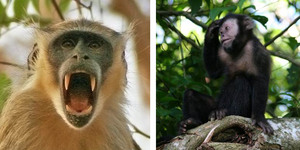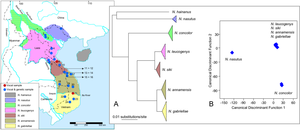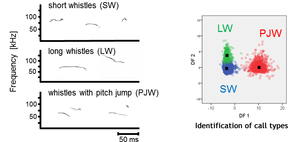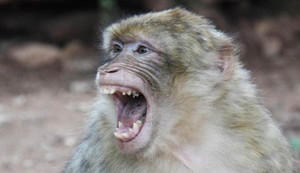Acoustic Communication
We study acoustic communication from an evolutionary and comparative perspective. Within this framework, our research focuses on two major topics. Firstly, we are interested in the evolution of signals, and how these tie in with the social system of a species. Secondly, we study the cognitive foundations of responses to signals, and how monkeys integrate information from different sources. In addition to nonhuman primates, we use mouse ultrasonic vocalizations (USVs) to explore the influence of specific genes on communication and social behavior. We actively contribute to the development of novel methods such as clustering methods to advance comparative analyses of vocalizations. Our ultimate aim is to identify the constraints and selective pressures that shape the evolution of vocal communication, including the evolution of human speech.
Selected Projects
Call meaning

- Quantitative analyses of vervet monkey and capuchin vocalizations reveal a graded structure (Price et al. 2015, Wheeler & Hammerschmidt 2013)
- Acoustic structure and context affect meaning attribution in green monkeys and capuchins (Wheeler & Hammerschmidt 2013, Price & Fischer 2014)
- What is the role of hormones in capuchin tactical deception? (Wheeler et al. in prep)
Phylogeny and vocalizations

- Gibbon and leaf monkey loud calls correlate with phylogenetic and geographic distance (Thinh et al. 2011, Meyer et al. 2012)
- Baboon vocalizations show only little structural variation between taxa, while the usage varies (Maciej et al. 2013)
- Phylogenetic constraints limit the evolution of vocal communication
(Hammerschmidt et al. in prep)
Mouse ultrasonic vocalizations

- Mouse USVs are an important model to elucidate the genetic foundations of communication (Fischer & Hammerschmidt 2011)
- Mice carrying the humanized variant of the FOXP2 gene implied in speech evolution reveal only minor variation (Enard et al. 2009)
- Mice do not require auditory input for normal vocal development
(Hammerschmidt et al. 2012) - Mice that do not have a cortex produce normal USVs (Hammerschmidt et al. 2015).

Methods
- Recording of vocalizations
- Acoustic analyses using LMA, Avisoft, Praat and MatLab
- Field experiments
- Playback experiments
- Presentation of predator models
- Manipulation of feeding competition
- Description of vocal repertoires
- k-means and hierarchical clustering
- Fuzzy clustering (Wadewitz, PhD Project)
- Super-paramagnetic clustering and affinity propagation
(Wadewitz, PhD Project)
Collaborations
- Bernstein Center for Computational Neuroscience
- MPI for Dynamics and Self-Organization, Göttingen
- MPI for Experimental Medicine, Göttingen
- MPI for Evolutionary Anthropology, Leipzig
- University of Pennsylvania, Philadelphia
- Primate Genetics and Endocrinology Laboratories (DPZ)
